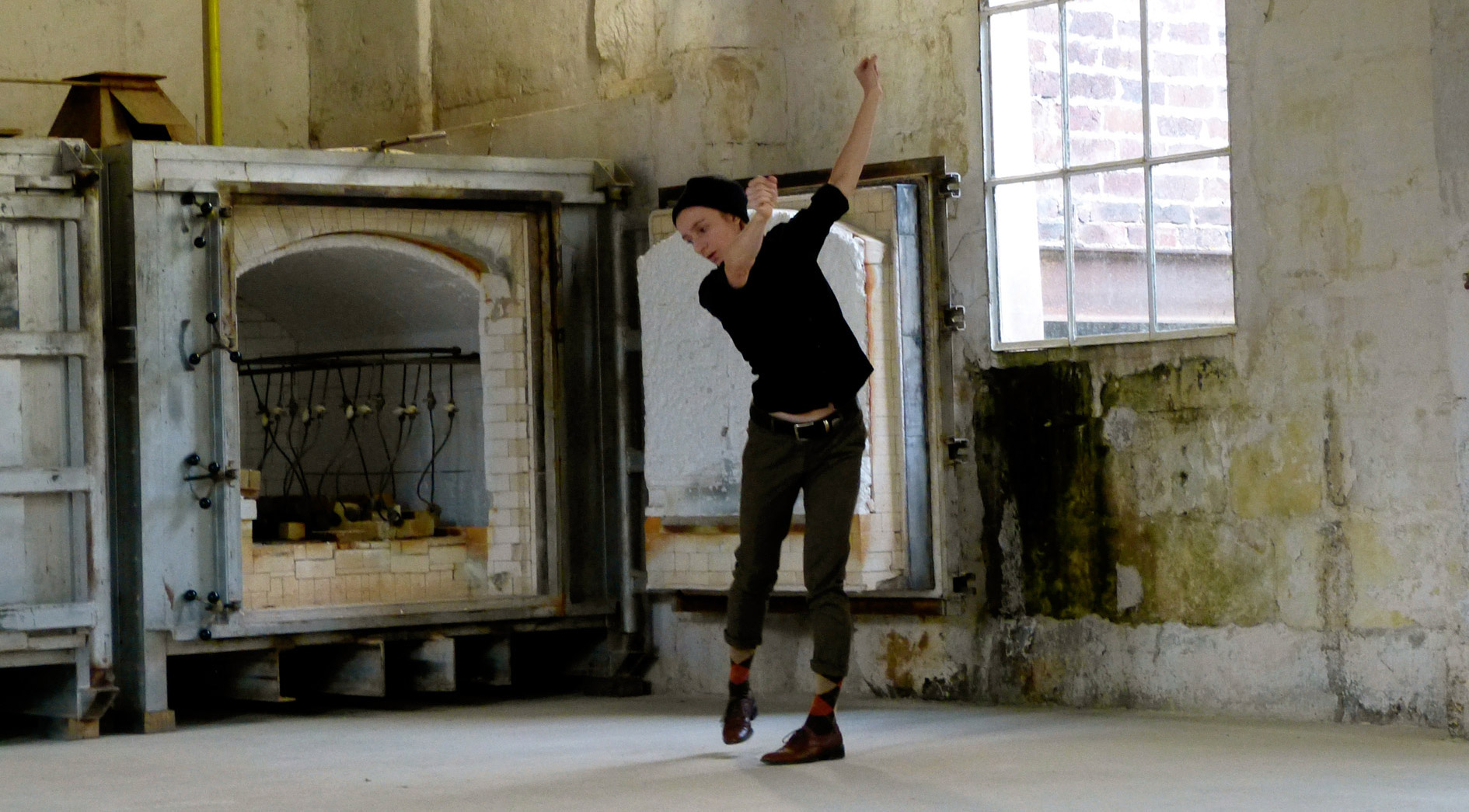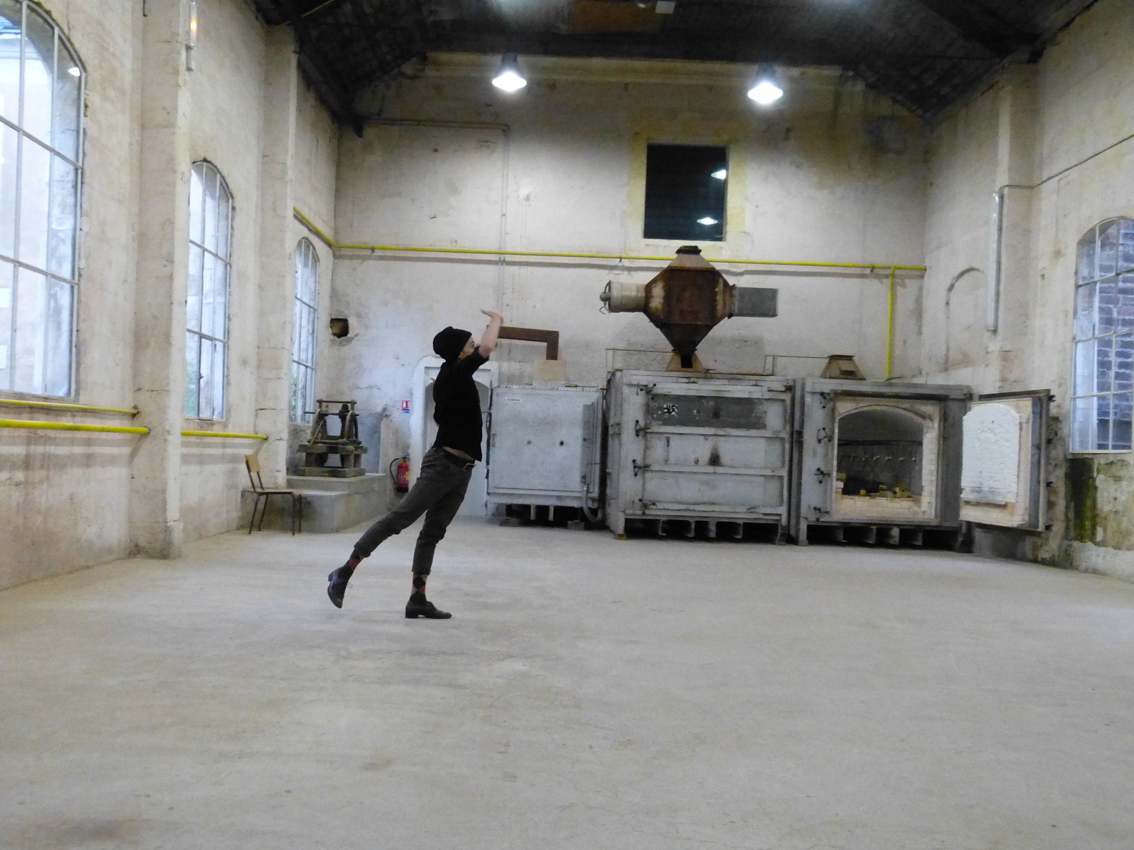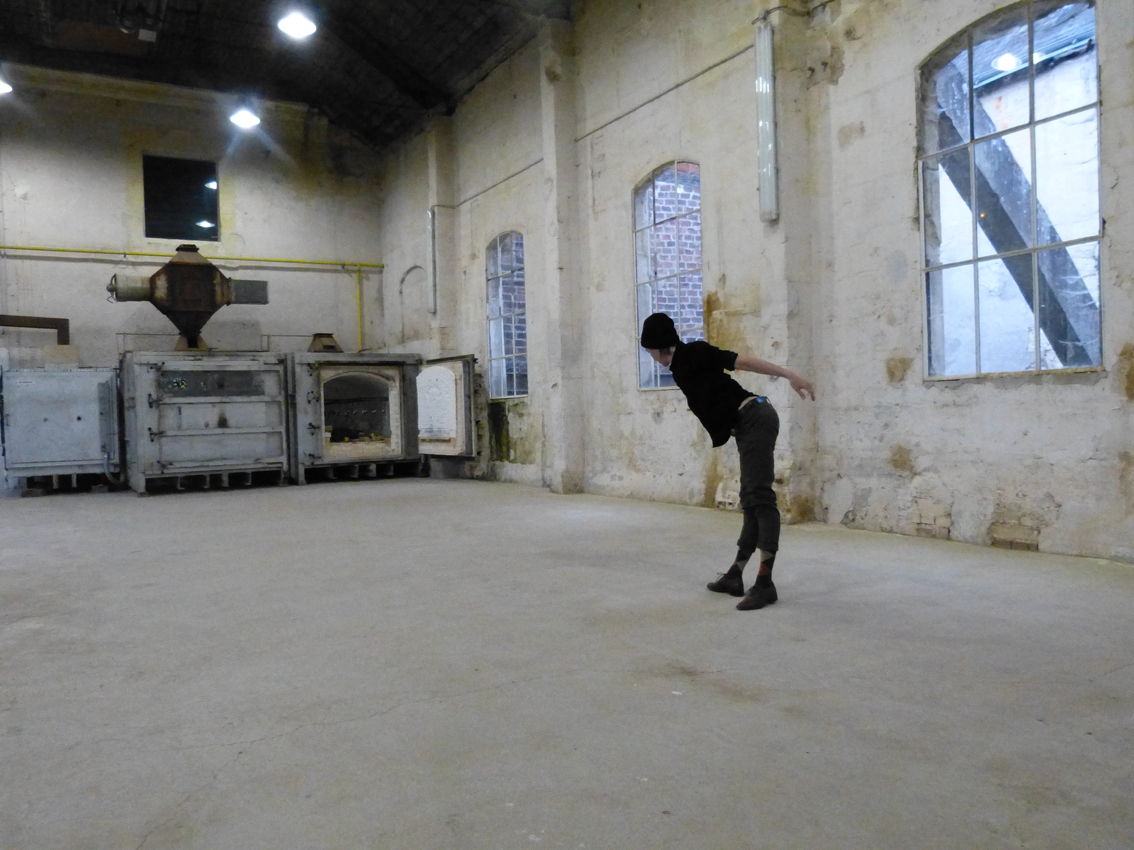« DYNAMIC » measuring silence
(2012)
In memory of Gill Clarke 9/12/1954 – 15/11/2011
Chorégraphie : Debora Hay
Adaptation : Marika Rizzi
« DYNAMIC » est le dernier solo que la chorégraphe Deborah Hay a créé pour le projet SPCP (Solo Performance Commissionning Project), projet qu’elle a mené entre 1998 et 2012. Pendant une période de 10 jours Deborah Hay transmet la partition du solo à une vingtaine de danseur.ses/performeur.ses. À la suite des dix jours de résidence, les participants s’engagent à répéter la partition chaque jour pour une période de neuf mois avant de le présenter publiquement en tant que spectacle. Le titre et l’origine du travail sont les mêmes tandis que l’interprétation singulière de chaque danseur donne vie à vingt solos différents. Pour tout dire, la période d’engagement était de trois mois jusqu’à « DYNAMIC ». Étant donné que ce solo allait être le dernier du long projet SPCP, Deborah nous a fait le cadeau surprise des neuf mois de pratique journalière. Le moment de la signature du contrat était assez paradoxal, comment pourrait-on vérifier que chacun.e répète la partition tous les jours ? C’est impossible, on en convient, mais voilà … quand il s’git de Deborah Hay l’impossible et le paradoxe deviennent des cartes joker, c’est clairement grâce à elle que le jeu tourne à la faveur du celui et celle qui sait les utiliser. J’était bouche bée en apprenant le temps de grossesse de ce solo mais j’ai quand-même adoré ce moment d’absurdité.
J’étais aussi particulièrement touchée et reconnaissante que « DYNAMIC » soit dédié à Gill Clarke, magnifique danseuse à qui toute une génération d’artistes chorégraphiques londoniens doivent l’existence d’Independent Dance, fions-nous à son appellation pour saisir la portée de cet organisme ! Quant à Gill, nous nous sommes rencontrées grâce à Kirstie Simson lors d’une rencontre à Casina Settarte en Italie où elle avait réuni des personnalités proche d’elle et de sa vision de l’improvisation. (C’est là qui est né le film « Force of Nature »). Chez Gill j’ai perçu la même aisance que j’avais perçu chez Simone Forti au moment où on entre dans l’espace d’improvisation. Ce sens de continuité entre l’avant et le début d’une danse instantanée, il est lisible dans la marche, dans le corps, dans la pensée. Quand ce passage est dépourvu de tensions le geste devient magique parce que déchargé de volonté inutile tout en étant complètement présent. J’ai appris ça de ces deux grandes dames et immanquablement je pense à elles dans des situations similaires.
DESCRIPTIF
« DYNAMIC » a fait l’objet d’un film documentaire autour du processus de transmission : « Turn Your F*^king Head » a été réalisé par Becky Edmunds et produit par Rutledge Books.
« Tu rentres, avec l’air de quelque chose comme un canard. On peut dire que tu te sens bête, et on peut voir que tu ris de toi même. En avançant, tu cherches un endroit pour couver.»
La partition de « DYNAMIC » commence comme cela, par les postulats «tu te sens bête» et «tu ris de toi même» : d’emblée le rôle de l’humour, de l’inconfort et de l’absurde est posé. Le solo continue par une suite d’indications spatiales très précises dans lesquelles Deborah Hay dit avoir inscrit ses danses les plus belles.
L’acte dansé dans la pratique de Deborah Hay est guidé par l’application constante d’un certain nombre de questions qui mettent en jeu l’état cellulaire du corps. La composition de la danse s’adresse donc à quelques dizaines de milliers de milliards de cellules en même temps, en relation à l’environnement et au temps qui passe.
La tâche à accomplir est impossible. La richesse du travail n’est pas dans un résultat à atteindre, l’invitation étant même de ne pas vouloir apprendre comment faire.
Il s’agit plutôt de partager la recherche incessante dans laquelle le corps en mouvement évolue. Ce sont les perceptions du corps qui bouge qui dévoilent la composition au sein de la partition du solo et façonnent l’esthétique du geste.
C’est là un renversement qui s’opère : affronter la performance à partir de la certitude de ne pas pouvoir répondre à ce qui est demandé, de n’avoir aucune chance d’y arriver en acceptant de ne pas savoir. Un récit de l’attention se dessine dont le sens demande à être formulé par des circuits non-linéaires.
PARTITION DU SOLO
“Dynamic” (2012)
in memory of Gill Clarke 12/9/1954 – 11/15/2011
choreography, text, and direction: Deborah Hay
With:
Gry Bech-Hanssen
Aura Fischbeck
Miguel Guzman
Detta Howe
Miriam Jakob
Antonija Livingstone
Janne-Camilla Lyster
Cinira Macedo
Megan Metcalf
Laurence Nguyen-Monnot
Gulsen Ozer
Marika Rizzi
Ana Rocha
Christopher Roman
Matthias Sperling
Shannon Stewart
Maria Svensson
Emily Sweeney
Asher Woodworth
Olga Zitluhina
“In order to get the most from this work, you will want to notice and redirect your reliance on your physical body and what it can do. Redirecting this dependence requires an unselfish regard for your whole body at once as a cogent medium for indefinable specificity. You are thus positioned to learn without thinking.” Deborah Hay, 7/10/2012
Solo Performance Commissioning Project, Aug 29 – Sept 7, 2012
Universal Hall, Findhorn, Scotland
Administration: ID (Independent Dance), London, England
Iris Chan and Fiona Millward
In collaboration with Bodysurf Scotland
Tools for the practice of the performance of Dynamic
What if my whole body at once is my teacher?
What if the question “What if where I am is what I need?” is not about what I need but an opportunity to inhabit the question “What if where I am is what I need?” ?
What if dance is how I practice relationship with my whole body at once in relationship to the space where I am dancing in relationship to each passing moment in relationship to my audience? What if the depth of this question is on the surface?
What if my choice to surrender the pattern, and it is just a pattern, of facing a single direction or fixing on a singularly coherent idea, feeling, or object when I am dancing is a way to notice where I am not?
What if how I see while I am dancing, including what I imagine, invent, project, can and cannot see in a prescribed area near, mid-range, and far, at any given moment, is a means by which movement arises without my looking for it?
Advice for the practice of the performance of Dynamic
Remember to turn your fucking head.
Your perception of time is relentless throughout. This includes the perception of your movement as your music and your perception of time passing.
Use your perception of space to enlarge the experience of your dance at any given moment.
Remove hesitation and reconsideration from your dancing.
Avoid slow motion movement at all costs.
Remove your sequencing from the sequence of movement directions that describe Dynamic.
Do not lose command of how you use your weight. Arms do not hang or swing casually. There is no room for rest.
Within the frame of this material, avoid the impulse to:
– be unique, or original, and/or creative, and
– illustrate language through movement.
Instead, dis-attach from those impulses by:
– noticing the whole body at once as your teacher, thus assuming the cellular intelligence of your body, and
– including your visual field, which includes what you can and cannot see, while you are dancing.
Using your voice in Dynamic
Your voice, whether singing or speaking, is a primary choreographic component of Dynamic.
I rely heavily on not thinking when I sing because I do not know how to think about singing. I rely on what has been absorbed without much thought, in terms of memory, patterns, history. I hear each song as it leaves my body, and I refrain from trying to make it anything other than what I hear as it emerges.
Two simple spontaneous melodies, sung without a need to project, hold Dynamic together. Intermittent periods of silence, within each song, add volume to the occasion.
Your song’s words are not translatable, although the cadence and phrasing make it sound like an actual language is being used. For a host of obvious reasons, you do not want to sound as if you are singing in a foreign language like French, Japanese, German, etc. Among other effects, it will separate you from your audience.
There are two choreographed clicks to learn. Each very short explosive click originates in the lower abdomen and is instantaneously forced from your mouth. You cut short the sound the moment it is produced.
ca: Press the back of your tongue to the roof of your mouth, slightly open and widen your lips, and from your belly, force a breath sound “ca” out from behind your tongue. Immediately shorten the act and return your lips to normal.
de: With the tip of your tongue pressed to the top of your palate about one-quarter inch behind your teeth, slightly purse your lips while you force your breath, from your lower abdomen, to free your tongue. Immediately shorten the act and return your lips to normal.
“Dynamic” (2012)
In memory of Gill Clarke 12/9/1954 – 11/15/2011
choreography, text, and direction: Deborah Hay
[For the sake of simplicity, Dynamic’s score is written for a proscenium stage, although the dance can be practiced anywhere and in any audience/performer spatial relationship you choose or that chooses you.]
Preset: Before you enter, put a piece of food into your mouth that you can chew and swallow by the time you begin the dance. You enter, something like a duck. We can tell you feel silly, and we can see you laughing at yourself. Traveling only forward, you are looking around for a place to roost, settling near the edge of the space.
Upon choosing a place to begin the dance, you find comic movements without acting funny. Getting to the floor, you assume a minimally composed shape.
How you see, from the assumed position, is inclusive of everything you can and cannot see, imagine, invent, project, create. Whatever you fleetingly notice is free of identification. A figure a sea is a useful perspective on your assumed position in the surrounding space.
You sing this sea, this stage, this moment, and you hear the spontaneous melody, as does the audience. The song has intermittent pauses that, combined with the song, eventually gain substance in your body as well as in those of the audience. This takes time. The body remains still while the head is moving.
With its interludes of silence and phrasing, the song establishes its hold. Outside of the song’s influence, no more than twice, a single movement of one or two limbs may be tagged onto your floor position. This is performed in a direct yet offhand manner, free of association. There is interplay between the seeming casualness of your gestures, the fullness of the song, the held pauses, and the constancy of your attention to time, space, and dynamic.
From the floor, you rise, zigzagging without illustrating or representing zigzag. What if you call wherever you are zigzagging? The song continues to guide the dance.
You cross the stage following a path that contains a perfect circle. The clearer the circle is in your experience, the freer you are from illustrating it—which is your challenge. To arrive at and depart from the circle, a single traveling movement is repeated like a little stitch. Several examples of the whole path are drawn below.
A practice of the performance of weaving is how the circumference of the circle is made, yet no one in the audience would necessarily identify your actions as such. Remembering to call your movement weaving is constant. At the same time, you are making choreographic choices that help maintain a finer interest in the performance of your dynamically subtle, impeccably timed, and succinctly unpredictable dance. Short phrases of at least two notes from your song continue to come and go, just enough to keep the presence of the song in your dance.
At the end of the path, not the end of anything else, your song plus a single movement repeat and combine rhythmically, the two elements illustrating each other. You and the audience alike realize a sustained visual and aural effect from those parallel actions.
“Ca” is performed in less than a fraction of a second. No one sees it.
With the memory of the rhythmic song and movement intact, everything changes, although this is not obvious. Therefore everything changes needs enough time for everyone to recognize that everything has changed. Phrases from the song, now quieter, are performed as if time collapsed.
“De” is performed in less than a fraction of a second, and no one sees it.
Moving rapidly, without struggle, lift your body mass away from the floor as you turn without turning, navigating a teardrop path covering at least half the stage. Use or don’t use your arms, more or less. The work is to remain as simple as possible in relation to the movement while becoming as sophisticated as possible in terms of your perception of time, space, and dynamic. You want to give the impression that this activity is habitual, but it is not. The teardrop path is then repeated, is reversed, and does not have to be completed. We hear whispered and limited phrases from your song.
The area contained within the teardrop is entered and filled to capacity as you practice the performance of intimacy. Intimacy within a teardrop is poetically useful to your whole body at once as your teacher. To avoid falling into the trap of illustrating or doing intimacy, these questions need recycling again and again:
What if how I see while I am dancing, including what I imagine, invent, project, can and cannot see, in a prescribed area near, mid-range, and far, at any given moment, is a means by which movement arises without looking for it?
What if wherever I am intimacy is?
What if my whole body at once is my teacher?
Quietly confidential phrases can be heard.
“Ca” is performed in less than a fraction of a second without anyone seeing it.
Not an announcement, but speaking clearly with a fake accent, you realize aloud, “The very thing I thought I lost I hadn’t lost.” Heard, you resume practicing intimacy.
Without pretense or finality, you march offstage, lightly repeating the word phrase, “dumb dumb da-dumb dumb.” Without pause, you sing a beautiful new song in a choreographed voice. The song gives volume to the stage, a sea.
While singing, and in direct relation to your song and its pauses, you perform three movements without facing a single direction. By choosing to surrender any frontality, you erase a destination.
1) To return to stage, step into the song you have sung. Place your weight on your forward stepping leg before your other foot lifts lightly behind you, bending at the knee. The arms play a supporting role.
2) In place, with both knees together, bend and straighten your legs repeatedly.
3) With both hands parallel in the air above your head, flutter them diagonally downward so that they cause a vibrato in the last note or notes you are singing.
You click “ca,” followed by a delayed bodily response. “De” succeeds, with another delayed response, and “ca” follows, with a final delayed response. One of them is brief.
The phrase “The very thing…” is spoken with or without a foreign accent and directed to the audience. If there is a spontaneous conclusion to the phrase, at that moment, you finish the sentence aloud. If not, the clicking and delayed response combination repeats until the phrase “The very thing…” is completed.
To support the composition of your exit, apply the question, “What if my will is my destiny?”
“And I think for the first time I understood that the questions/practices reside in the body, not the head; or rather that the practice is in moving the question from the head into the body; and the discipline is in schooling the body to be the questioner (or the question).”
– John Slatin, a dear friend who was blind and a professor of English at the University of Texas in Austin
The lights fade after the audience is given time to contemplate the stage without you.
DATES
9 avril 2013 | Festival Hautes Tendances, Strasbourg
Mai 2013 | Les Moulins de Paillard – Centre d’Art Contemporain
Décembre 2013 | Canaldanse, Paris
Mai 2017 | Le Magazin, St. Etienne
Coproduction
Ballet de l’Opéra National du Rhin / CCN de Mulhouse dans le cadre de l’accueil studio 2013, Festival Hautes tendances, Strasbourg, ass. SPONTE.
Avec le soutien
du CND Centre National de la Danse,
Ménagerie de Verre dans le cadre du Studiolab,
Canaldanse,
Les Journées Danse Dense et la Ville de Pantin,
Les Moulins de Paillard – Centre d’Art Contemporain.
Ma plus sincère gratitude pour leur aide à :
Simon Ellis, Mario Rizzi, Rosetta Colombo, Cathérine Jodoin, Sergio Longobardi, Laurence Nguyen-Monnot, Bruno Pocheron, Françoise Feraud.



